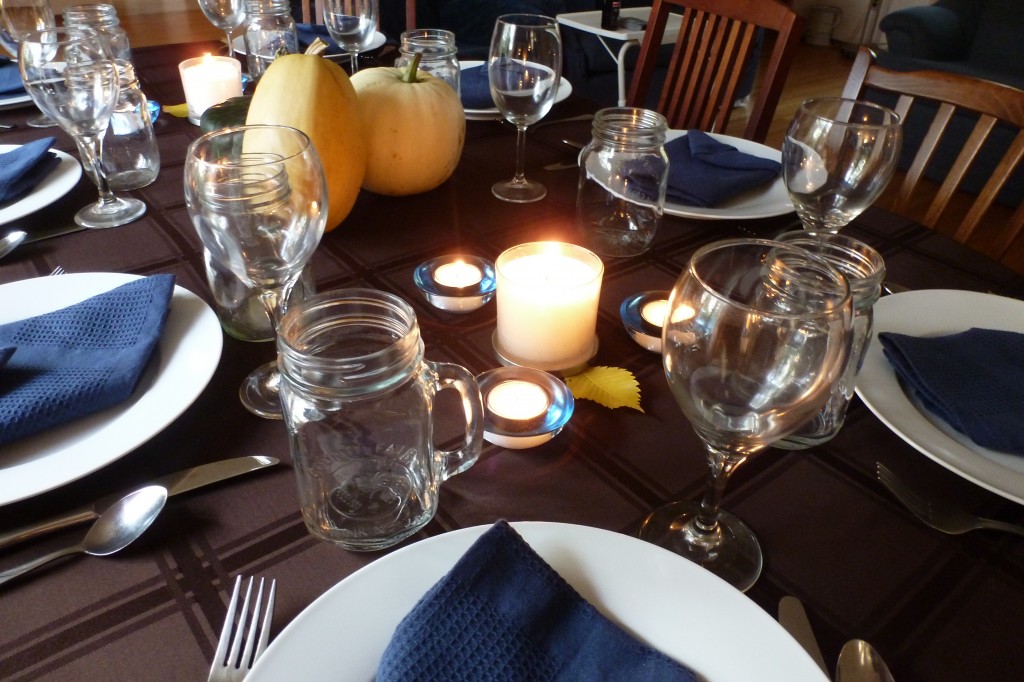Turkey is certainly one of the finest gifts made by the New World to the Old.
-Brillat-Savarin in The Physiology of Taste
 The Saturday morning of Thanksgiving weekend we pick up a turkey from the Four Whistle truck at Old Strathcona, then take it home and cut it up, usually into two suprêmes (breasts with the drumette still attached) and two leg-thighs. I know: bringing the whole roasted bird to the table, and carving that bird in front of the guests, is an indispensable part of Thanksgiving. I appreciate the pageantry of tableside carving, but there are some huge advantages to separating the bird.
The Saturday morning of Thanksgiving weekend we pick up a turkey from the Four Whistle truck at Old Strathcona, then take it home and cut it up, usually into two suprêmes (breasts with the drumette still attached) and two leg-thighs. I know: bringing the whole roasted bird to the table, and carving that bird in front of the guests, is an indispensable part of Thanksgiving. I appreciate the pageantry of tableside carving, but there are some huge advantages to separating the bird.
With the bird broken up into smaller pieces I can sear them to jump-start the browning. Each piece can then be removed from the oven at the proper temperature (165°F for legs, 155°F for breasts). Also, the turkey cooks in under an hour, which makes our Thanksgiving timeline less stressful and more flexible.
Finally, with the remaining carcass I can make a stock to be used at the same dinner as the meat. We have essence of turkey to add to the soup, the stuffing, and many of the vegetable accompaniments.
I think the above gastronomic benefits trump Thanksgiving ritual.
For a few years I was riding the brine bandwagon, and I’d submerge the turkey bits in a simple solution of salt, brown sugar, and sage. More recently I’ve simply been laying to two breasts and the two legs on a wire rack, seasoning them generously with salt, black pepper, and herbs, then leaving the turkey uncovered in the fridge until Monday. The skin dries out so that it will brown well in the oven.
Once the bird is cut and resting in the fridge, it’s time to make turkey stock.
Making Turkey Stock
My general stock-making procedure is outlined here. Really the only difference between my turkey stock and chicken stock is that the turkey stock is very herbaceous, especially with sage.
Here’s my complete turkey stock method.
Turkey Stock
Ingredients
- carcass of one 10-15 lb turkey, including neck, gizzard, and wingtips
- 1 large onion
- 2 ribs celery
- 2 carrots
- 1 small head of garlic
- 3 bay leaves
- roughly 2 cups dry cider
- roughly 6 L very cold water
- 1 bunch thyme
- 1 bunch sage
- 1 bunch parsley
- 5 black peppercorns, crushed
Procedure
- Roast bones in a heavy pan at 350°F until thoroughly browned. Remove and set aside.
- Roast the vegetables in rendered turkey fat until browned. Remove a reserve for later use.
- Pour any excess fat from the pan. Deglaze the pan with the dry cider and reduce au sec.
- Put the roasted bones and the cider reduction in a stock pot and cover with cold water. Bring to a boil then simmer very gently for 24 hours.
- Add the roasted vegetables to the pot. Return the liquid to a boil and simmer gently for 2 hours.
- Add the herbs and peppercorns. Simmer gently for 15 minutes.
- Strain the mixture and chill thoroughly. Once chilled, remove any fat from the surface of the stock.
Please, please save the abovementioned fat and fry something in it. Here’s an idea:
Turkey Gravy
I know gravy is supposed to be made from pan juices, but if there’s loads of juice in your roasting pan, doesn’t that mean your meat is dry? I prefer to make gravy from stock, fortified with the minimal drippings in the roasting pan.
Ingredients
- 1/4 cup turkey fat, either from the roasting pan, or reserved from the chilled stock
- 1/4 cup all-purpose flour
- 1/2 cup dry cider
- 1 L turkey stock
Procedure
- Deglaze the roasting pan with the dry cider. Reduce the cider to 1/4 its original volume.
- In a separate pot, combine the fat and flour. Cook out the flour for about 5 minutes.
- Stir the cider and stock into the roux. Adjust seasoning and consistency.
